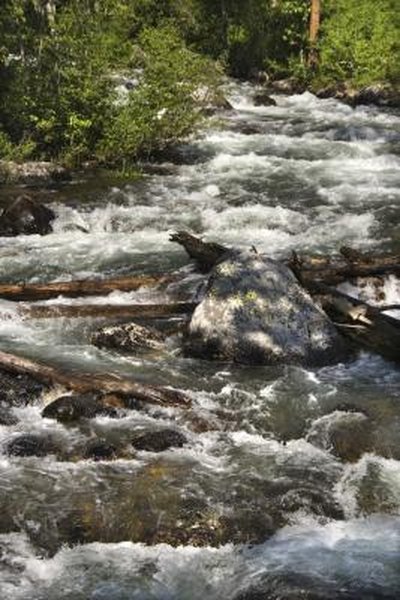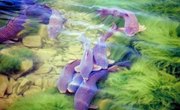
The trout stream has a constant supply of cold water, healthy insect population and places where the trout can escape predators and rest. Building a trout stream is a not a complex task, but several environmental factors must be met. The construction also must be approved through permits by the state government. The length and width of the stream varies, but a large water supply is required for a large stream. Small streams are a more common option given the limited availability of fresh water resources in most regions.
Items you will need
Water source
Permits
Backhoe
Gravel
River rock
Boulders
Logs
Living willows
Native plants
Trout
Step 1
Locate a year-round, freshwater source with enough volume to maintain a current through a small stream. Springs with containment are ideal. You may also divert water from an existing river to build a separate trout stream.
Step 2
Draw the plans for your trout stream in coordination with a biologist. Submit the plans to your state land management agency and wait for approval. Do not begin the construction until the permits are approved.
Step 3
Dig the stream bed with a backhoe. Leave a 10-foot gap between the artificial channel and the water source. Create a meandering pattern and fill the bed with gravel and river rocks to stabilize and define the stream. The stream must be on a declining grade to create a current.
Step 4
Plant willows, trees and native plants along both banks of the stream. The water feeds the plants and the plants stabilize the banks and prevent erosion. The plants also provide shade to cool the water during hot months. The trout may die if water temperatures remain higher than 70 degrees Fahrenheit for several days.
Step 5
Add large rocks, boulders and logs to the stream bed to break current and create oxygen. The oxygen encourages insect populations and is necessary for trout survival. Create as much oxygen as possible to combat high water temperatures and provide a comfortable environment for trout. The current will also scour deep holes around the objects and provide the trout cover from predators.
Step 6
Break the dam between the water source and the stream. Allow the water to navigate the stream bed and monitor the banks on a daily basis for one month. Add boulders and logs to loose bank areas where erosion is an issue.
Step 7
Wait for insect populations to become evident before stocking the trout. Stock a small population and monitor the general health of the population before stocking numerous trout.
Writer Bio
Zach Lazzari is a freelance outdoor writer specializing in hunting, fly fishing and the general outdoors. He guided fly fishing trips for 10 years in Colorado, Alaska, Montana and Patagonia-Chile. Zach lives in Montana and splits time between the river and keyboard.


